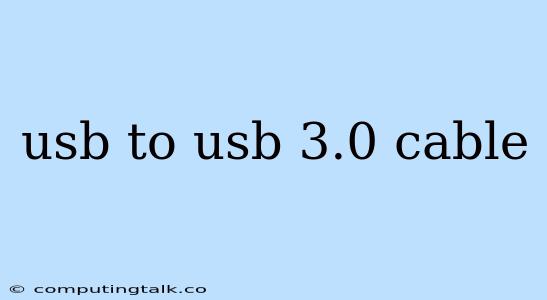Need a Faster Connection? Upgrade to a USB to USB 3.0 Cable!
Have you ever felt frustrated by slow file transfers or sluggish performance from your external hard drive? It might be time to consider upgrading to a USB to USB 3.0 cable. This simple upgrade can dramatically improve your data transfer speeds, making your workflow faster and more efficient.
What is a USB to USB 3.0 Cable?
A USB to USB 3.0 cable is a type of cable that connects two USB devices, one of which must have a USB 3.0 port. The key difference between a standard USB cable and a USB 3.0 cable lies in the data transfer rate. USB 3.0 cables support much faster data transfer speeds than older USB 2.0 cables.
Why Choose a USB to USB 3.0 Cable?
Here are some of the benefits of using a USB to USB 3.0 cable:
- Faster Data Transfer Speeds: USB 3.0 cables can transfer data up to 10 times faster than USB 2.0 cables. This means you can transfer large files, like videos or photos, in a fraction of the time.
- Improved Performance: Faster data transfer speeds also improve the overall performance of your devices. For example, you'll experience less lag when using an external hard drive connected with a USB 3.0 cable.
- Backward Compatibility: USB 3.0 cables are backward compatible with USB 2.0 ports. This means you can use a USB to USB 3.0 cable with a USB 2.0 port, but you won't get the full speed benefits.
Choosing the Right USB to USB 3.0 Cable
When selecting a USB to USB 3.0 cable, there are a few factors to consider:
- Cable Length: Choose a cable length that is appropriate for your needs. Shorter cables often offer better performance, while longer cables may be more susceptible to signal loss.
- Cable Type: There are different types of USB cables, including A-to-A, A-to-B, and C-to-C. Make sure you select the correct type of cable for your devices.
- Durability: Look for cables with durable construction, like braided or shielded cables, that can withstand repeated use.
Connecting a USB 3.0 Device
To connect a USB 3.0 device with a USB to USB 3.0 cable, you'll need a device with a USB 3.0 port. Look for a blue port on your computer or other device to indicate a USB 3.0 connection.
Once you have the proper cable and devices, simply plug one end into your device and the other end into your computer. Windows will typically recognize the device automatically and prompt you to install drivers if needed.
Troubleshooting
If you are experiencing slow data transfer speeds even after using a USB to USB 3.0 cable, there are a few things you can try:
- Make sure your device is connected to a USB 3.0 port. If you are using a USB 2.0 port, you will not get the full speed benefits of a USB 3.0 cable.
- Check your device's drivers. Outdated or corrupted drivers can affect performance. Update your drivers to the latest version for optimal performance.
- Try a different USB cable. Sometimes, a faulty cable can be the cause of slow data transfer speeds.
Conclusion
Upgrading to a USB to USB 3.0 cable is a simple and affordable way to improve the performance of your devices. With faster data transfer speeds, you'll be able to work more efficiently and enjoy a smoother user experience. Just make sure you have the correct cable and devices for optimal results.
